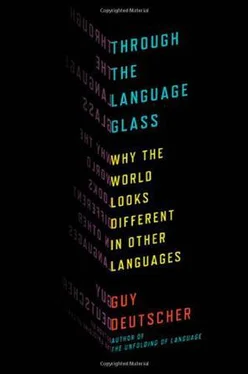Needless to say, genders cheer up the everyday life of ordinary mortals too. Genders may be a nightmare for foreign learners, but they do not seem to cause any serious trouble to native speakers, and they make the world a livelier place. How tedious it would be if bees weren’t “she’s” and butterflies “he’s,” if one didn’t step from feminine pavements to masculine roads, if twelve masculine months didn’t crowd inside one feminine year, if one couldn’t greet Mr. Cucumber and Lady Cauliflower in the proper way. I would never want to forfeit my genders. Along with Aunt Augusta, I would rather say to the English language that to lose one gender may be regarded as a misfortune; to lose both looks like carelessness.
Visitors to Japan in possession of a sharp eye might notice something unusual about the color of some traffic lights. Not that there is anything odd about the basic scheme: just like everywhere else, the red light in Japan means “stop,” green is for “go,” and an orange light appears in between. But those who take a good look will see that the green lights are a different shade of green from that of other countries, and have a distinct bluish tint. The reason why is not an Oriental superstition about the protective powers of turquoise or a spillage of blue toner in a Japanese plastic factory, but a bizarre twist of linguistic-political history.
Japanese used to have a color word, ao , that spanned both green and blue. In the modern language, however, ao has come to be restricted mostly to blue shades, and green is usually expressed by the word midori (although even today ao can still refer to the green of freshness or unripeness-green apples, for instance, are called ao ringo ). When the first traffic lights were imported from the United States and installed in Japan in the 1930s, they were just as green as anywhere else. Nevertheless, in common parlance the go light was dubbed ao shingoo , perhaps because the three primary colors on Japanese artists’ palettes are traditionally aka (red), kiiro (yellow), and ao . The label ao for a green light did not appear so out of the ordinary at first, because of the remaining associations of the word ao with greenness. But over time, the discrepancy between the green color and the dominant meaning of the word ao began to feel jarring. Nations with a weaker spine might have opted for the feeble solution of simply changing the official name of the go light to midori . Not so the Japanese. Rather than alter the name to fit reality, the Japanese government decreed in 1973 that reality should be altered to fit the name: henceforth, go lights would be a color that better corresponded to the dominant meaning of ao. Alas, it was impossible to change the color to real blue, because Japan is party to an international convention that ensures road signs have a measure of uniformity around the globe. The solution was thus to make the ao light as bluish as possible while still being officially green (see figure 7).
The turquoising of the traffic light in Japan is a rather out-of-the-way example of how the quirks of a language can change reality and thus affect what people get to see in the world. But of course this is not the kind of influence of language that we have been concerned with in the previous few chapters. Our question is whether speakers of different languages might perceive the same reality in different ways, just because of their mother tongues. Are the color concepts of our language a lens through which we experience colors in the world?
In returning to the subject of color, this final chapter tries to discharge an old debt, by turning on its head the nineteenth-century question about the relation between language and perception. Recall that Gladstone, Geiger, and Magnus believed that differences in the vocabulary of color resulted from preexisting differences in color perception. But could it be that cause and effect have been reversed here? Is it possible that linguistic differences can be the cause of differences in perception? Could the color distinctions we routinely make in our language affect our sensitivity to certain colors? Could our sensation of a Chagall painting or the stained-glass windows of Chartres cathedral depend on whether our language has a word for “blue”?

Few thrills of later life can match the excitement of teenage philosophizing into the small hours of the morning. One particularly profound insight that tends to emerge from these sessions of pimpled metaphysics is the shattering realization that one can never know how other people really see colors. You and I may both agree that one apple is “green” and another “red,” but for all I know, when you say “red” you may actually experience my green, and vice versa. We can never tell, even if we compare notes until kingdom come, because if my sensation was in red-green negative from yours, we would still agree on all color descriptions when we communicated verbally. We would agree on calling ripe tomatoes red and unripe ones green, and we would even agree that red is a warm color and green is a cooler color, for in my world flames look green-which I call “red”-so I would associate this color with warmness.
Of course, we are meant to be dealing with serious science here, not with juvenile lucubrations. The only problem is that as far as understanding the actual sensation of color is concerned, modern science does not seem to have advanced substantially beyond the level of teenage metaphysics. A great deal is known today about the retina and its three types of cones, each with peak sensitivity in a different part of the spectrum. As explained in the appendix, however, the color sensation itself is formed not in the retina but in the brain, and what the brain does is nothing remotely as simple as just adding up the signals from the three types of cones. In fact, between the cones and our actual sensation of color there is a whirl of extraordinarily subtle and sophisticated computation: normalization, compensation, stabilization, regularization, even plain wishful seeing (the brain can make us see a nonexistent color if it has reason to believe, based on its past experience of the world, that this color ought to be there). The brain does all this computation and interpretation in order to give us a relatively stable picture of the world, one that doesn’t change radically under different lighting conditions. If the brain didn’t normalize our view in this way, we would experience the world as a series of pictures from cheap cameras, where colors of objects constantly change whenever the lighting is not optimal.
Beyond the realization that the interpretation of the signals from the retina is enormously complex and subtle, however, scientists know fairly little about how the sensation of color is really formed in anyone’s brain, let alone how exactly it could vary between different people. So given the inability to approach the color sensation directly, what hope is there of ever finding out whether different languages can affect their speakers’ perception of colors?
In previous decades, researchers tried to overcome this obstacle by devising clever ways of making people describe in words what they experienced. In 1984, Paul Kay (of Berlin and Kay fame) and Willett Kempton tried to check whether a language like English, which treats blue and green as separate colors, would skew speakers’ perception of shades near the green-blue border. They used a number of colored chips in different shades of green and blue, mostly very close to the border, so that the greens were bluish green and the blues greenish blue. This meant that, in terms of objective distance, two green chips could be farther apart from each other than one of them was from a blue chip. The participants in the experiment were requested to complete a series of “odd man out” tasks. They were shown three chips at a time and asked to choose which chip seemed most distant in color from the other two. When a group of Americans were tested, their responses tended to exaggerate the distance between chips across the green-blue border and to underestimate the distance between chips on the same side of the border. For example, when two chips were green and the third was (greenish) blue, the participants tended to choose the blue as being farthest apart, even if in terms of objective distance one of the greens was actually farther away from the other two. The same experiment was then conducted in Mexico, with speakers of an Indian language called Tarahumara, which treats green and blue as shades of one color. Tarahumara speakers did not exaggerate the distance between chips on different sides of the green-blue border. Kay and Kempton concluded that the difference between the responses of English and Tarahumara speakers demonstrated an influence of language on the perception of color.
Читать дальше












